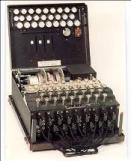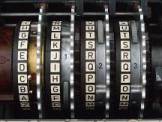

During World War II, the German military employed a typewriter-like device called the Enigma machine to encode and decode all communications. The Enigma machine utilized interchangeable rotors with internal circuitry that mapped each letter of the alphabet to a different letter. Placed side-by-side on a spindle, the rotors defined a complex substitution pattern, with the wires inside each rotor connecting to its neighboring rotors. When the operator hit a key on the Enigma keyboard, an electrical current would flow through the wires in the rotors, forming a closed circuit and lighting up the letter specified by the rotor substitution pattern. What made this scheme especially secure was the fact that before each letter was encoded, the rotors rotated in an automatic but complex pattern. These rotations effectively changed the substitution pattern each time a key was pressed. The full details of how the Enigma machine worked can be found at the Wikipedia article .

In addition to its impact on military history, the Enigma machine played an important role in the history of computers. Efforts to break the Enigma code led to the development of the first electronic computers at Bletchley Park, England: the Bombe (designed by Alan Turing) and its successor, Colossus (designed by Tommy Flowers). Using these computers, the Allies were eventually able to break the Enigma code, giving them an intelligence edge that changed the balance of the war.

The Do-It-Yourself Enigma machine is a paper model of the original German Enigma machine. Inspired by Mike Koss' Paper Enigma Machine, the DIY Enigma machine is constructed from single-page paper template. Individual components (the spindle and 3 rotors) are cut out of the template and made 3-dimensional by taping them into rolls. The rolls representing the rotors can then be slipped over the spindle to construct a working model of an Enigma machine. For simplicity, this paper model does not include the ring-settings and plugboard features that were added to the original Enigma design at the start of the war. In every other respect, however, this paper model that you can hold in your hand is an accurate model of the mechanical Enigma machines used by the German military.